One of the benefits of doing a back to back cruise is the chance to revisit a port. When that port is in Israel, and there are two stops on each itinerary, you can really travel the country in depth. This is not that usual on a cruise itinerary so we were excited to take advantage of this opportunity to really explore Israel.
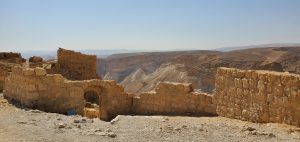 The country is not large so regardless of whether you docked in Ashdod in the south or Haifa in the north you can easily travel anywhere. We used the ship excursion for one of the stops in Ashdod but used Guided Tours Israel (https://www.guidedtoursisrael.com/) for the balance. Guides Ryan and Dikla were both tremendous and offered up a wonderful mix of historical and current events with a dose of the biblical in the mix. In order to best describe our time in Israel we really need to separate the two.
The country is not large so regardless of whether you docked in Ashdod in the south or Haifa in the north you can easily travel anywhere. We used the ship excursion for one of the stops in Ashdod but used Guided Tours Israel (https://www.guidedtoursisrael.com/) for the balance. Guides Ryan and Dikla were both tremendous and offered up a wonderful mix of historical and current events with a dose of the biblical in the mix. In order to best describe our time in Israel we really need to separate the two.
The main highway travelling the length of the country was only opened 15 year ago although construction started long before that. Significant delays arose as construction unearthed numerous artifacts and sites from Egyptian, Roman and other ancient times that needed to be recorded and explored before they could continue. It was evidence of the vast history of the area despite the fact that the country of Israel was not formed until 1948. In the aftermath of the Second World War it was recognized that the Jewish religion deserved their own home land.
long before that. Significant delays arose as construction unearthed numerous artifacts and sites from Egyptian, Roman and other ancient times that needed to be recorded and explored before they could continue. It was evidence of the vast history of the area despite the fact that the country of Israel was not formed until 1948. In the aftermath of the Second World War it was recognized that the Jewish religion deserved their own home land.
Today the population of about 9.7 million people supports a predominately agricultural and high tech economy. Road signs in Hebrew, Arabic and English attest to its diversity. Boosting two deserts and acres of wilderness the citizens occupy a congested portion of the country.
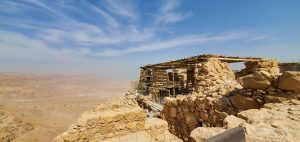
Our first historical stop was a visit to the mountaintop site of Masada. Originally built as a palace for King Herod it later became a site of refuge for Jews during the revolution. The great battle between the Romans and the Jews is outlined in the Peter O’Toole movie Exodus. Archaeological remains of the Roman encampments and the ramp they built to gain entry to the fort are evident. The site also offers a breath taking view over the countryside from its perch high above. 
From there we continued our travels down to the Dead Sea. We were able to access the water from a resort that offered visitors change rooms, showers and the chance to get refreshments and souvenirs. It is true what they say that everyone can float in the mineral rich waters and that the clay offers restorative powers when slathered directly onto your body. Just be sure not to get water in your eyes or mouth.
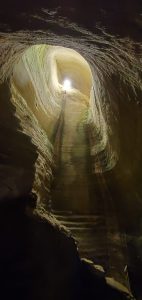 On our second historical trip to the area we travelled to the town of Beit Guvrin to explore a collection of ancient caves found in the Maresha National Park. The bell caves were dug between the 7th and 10th centuries and were still in excellent condition. Bell caves are characterized by a small opening at the top to crawl through and large hollowed out area below. We could still see the chisel marks in the stone. In one cave the stone steps had collapsed (in the 1970s no less) so an alternate opening was created. Being in good physical condition was an advantage as there was a lot of climbing up and down. As well I would not recommend it for someone who is claustrophobic.
On our second historical trip to the area we travelled to the town of Beit Guvrin to explore a collection of ancient caves found in the Maresha National Park. The bell caves were dug between the 7th and 10th centuries and were still in excellent condition. Bell caves are characterized by a small opening at the top to crawl through and large hollowed out area below. We could still see the chisel marks in the stone. In one cave the stone steps had collapsed (in the 1970s no less) so an alternate opening was created. Being in good physical condition was an advantage as there was a lot of climbing up and down. As well I would not recommend it for someone who is claustrophobic.
The homes above ground are long gone but what remains are the deep caves dug into the ground that were used as cisterns, animal pens, housing for pigeons and even burial grounds. We were able to see an ancient olive press, which was also used to press grapes for wine, and a burial cave that still had brightly coloured pictures adorning its walls. 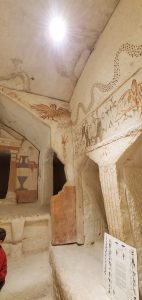
Our final stop this day was at an excavation featuring layers of both Roman and Medieval Crusade artifacts and buildings. The Roman Amphitheater was especially well preserved if on the smaller side with underground passages for the gladiators and animals and the remains of Roman baths.
Next week we will discuss the Biblical side of our tour of Israel.
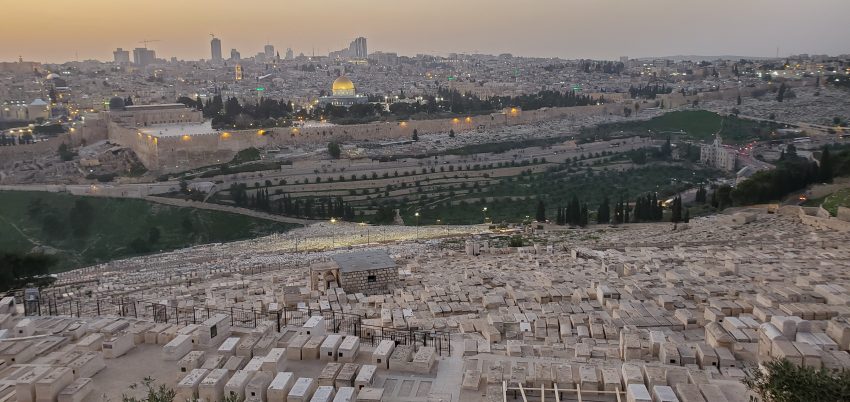
Israel is in the top of my bucket list! The story of Masada has also been more recently covered in the brilliant and engaging book The Dovekeepers bu A. Hoffman, where the dramatic saga is lived through three very different women. A movie ( shot in Malta, where I am headed this September) is also available for streaming on line.
The description of the caves sounds really fascinating, but I don’t think I’d be brave enough to crawl through! Wonderful articles on the Holy Land and such a great idea to offer the biblical as well as historical.
The saga of Masada has also been more recently covered in the brilliantly engaging book “The Dovekeepers” by Alice Hoffman, as well as a movie available on line. It follows the experiences of three very different women living through the siege. Israel is top of my bucket list; great articles!